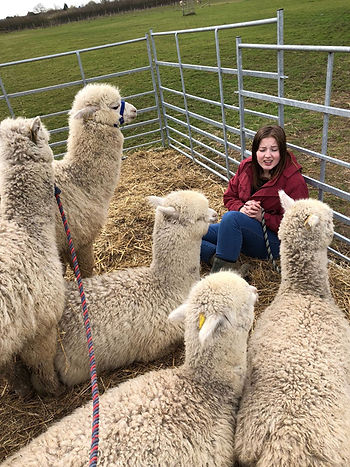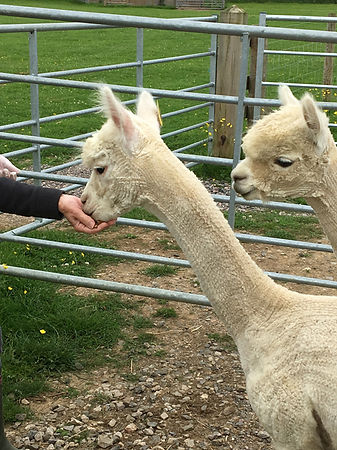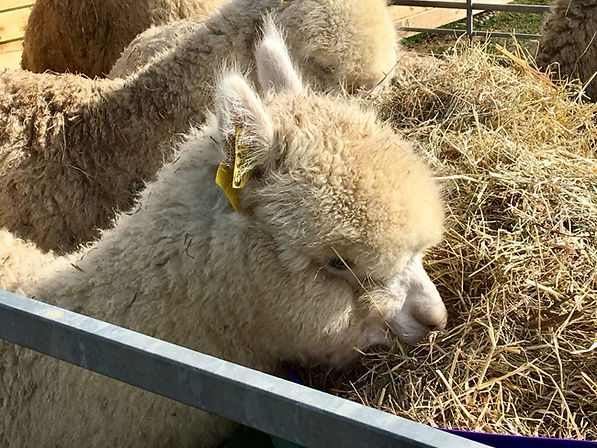Caring for alpacas
Behaviour: Alpacas are social herd animals
Alpacas live in family groups. Herd sires; in a separate paddock, but within sight of females and their cria. Alpacas will warn about intruders by sending off an ‘Alarm call’ they can be aggressive towards foxes which is why they can make good guards for sheep, lambs, chickens. They are also very gentle, intelligent and observant. These qualities also mean that alpacas will come to know you, your family and your pets very well and can differentiate between friend and foe.
Personal Space and body language
Alpacas set their own boundaries of personal space within their families and their groups. It takes time and patience to really get to know your animals but there are many supportive people in the alpaca community and some excellent good practice regarding handling and training methods. However knowing that body language is paramount in their communication, it does help to make yourself acquainted with the signs and signals.
Crouching head low and swan necked with their tail up over their back is the common submissive position. Ears flat back with head and tail held high would suggest an aggressive stance.
When alerted, usually by an alpaca alarm call, they stand still and tall, look in the direction of the ‘threat’ with ears up forward.
‘Camalid Dynamics’ by Marty McGee Bennett is the best source of research into all things alpaca.
Alpacas famously hide any signs of illness or vulnerability, get to know your alpacas and you will notice if their behaviour changes.

Sounds and communication
Typically Alpacas are known for their humming but they do have a rather more extended vocabulary for particular situations.
Alpaca mothers and cria hum to each other, the cria recognize their mother’s hum and connect. When a cria is born all the other alpacas stay silent until the mother and the new born can connect with each other’s hum tone. There are also other meanings in the humming these could be: curiousity, happiness, or cautiousness.
Other sounds to become aware of:
· Snorting - invading my space
· Clucking grumbling/gurgling - gentle warning to move away, especially from the cria
· Screaming – incorrect handling or being attacked
· Screeching – typically when two males are about to fight or are fighting
· Orgling - The mating sound. (induces ovulation)

To spit or not to spit … that is the frequently asked question
The myths around camelids spitting prevails, actually they only spit for certain reasons …it is usually reserved for other alpacas and consists of a puff of air as a ‘back off’ signal. The green grassy-mix spit is targeted at an irritant… that would be a male alpaca especially if the female is pregnant or an annoying or seemingly threatening human. Getting to know your alpacas; reading their body language and reducing their stress will avoid any inclination to spit!
Tidy and organized
When Alpacas poo they use a communal dung pile where they do not graze. This helps to limit the spread of internal parasites. This also happens to cause a chain reaction and alpacas poo together. Alpaca poo is a fantastic garden fertilizer.
Tooth care and hygiene
Checking the teeth of your alpacas is a good way of checking their digestive system. Alpacas have six lower incisors which helps them bite off grass and plants, they do not have upper incisors. Male Alpacas have an extra two teeth called fighting teeth.
Warning signs regarding any dental problems could be poor body condition, taking a long time to chew, spilling food from their mouth.
Body Condition
Regular body scoring is necessary to establish the general health and fitness of your alpaca. In full fleece it is not easy to see whether the alpaca is over or under weight. Body condition score is usually based on a scale of 1 to 5 but some breeders operate on a scale of 1 to 10. The principle is the same, very poor condition being 1, obese scoring 5 (or 10) the optimum body score is mid way.
Body scoring involves placing your fingers on the centre of the back either side of the vertebrae and feeling for muscle coverage. It should feel firm and slightly convex in shape.


